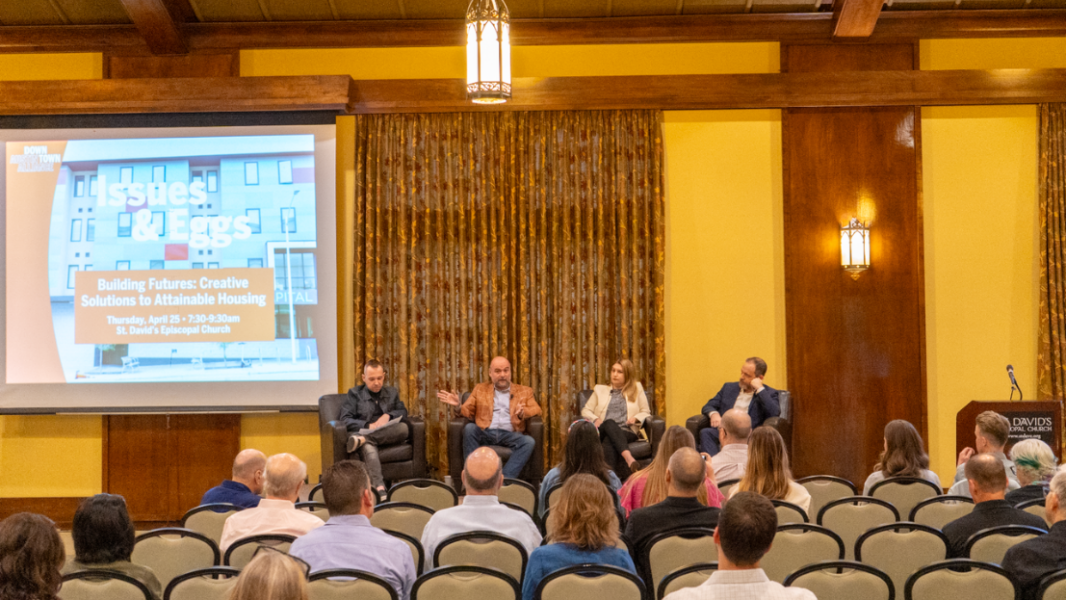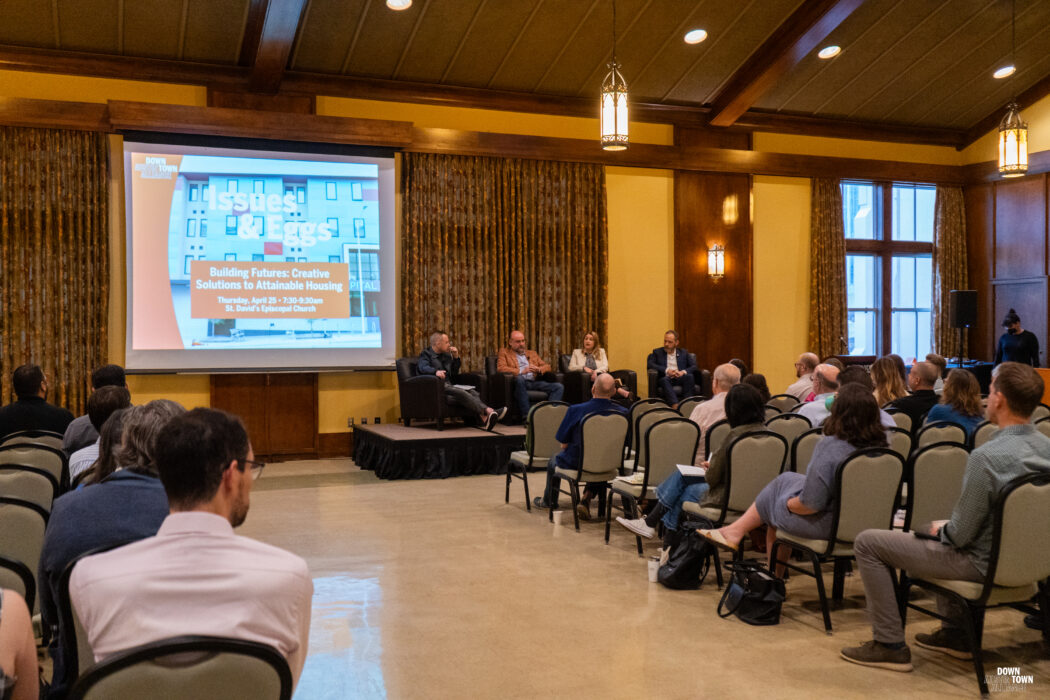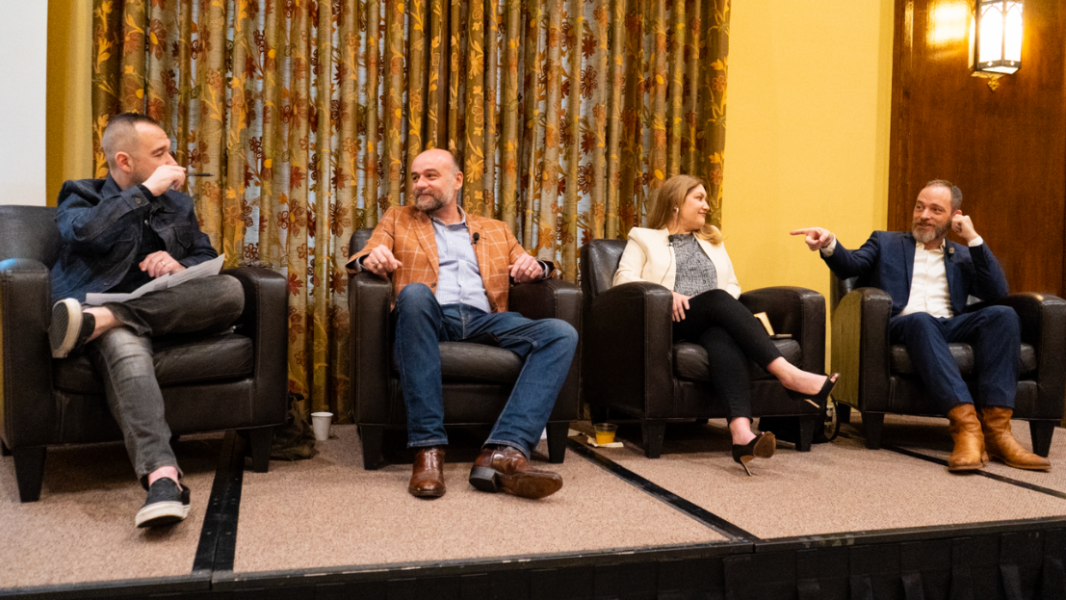On April 25, the Downtown Austin Alliance hosted “Building Futures–Creative Solutions to Attainable Housing,” an Issues & Eggs panel discussion focused on exploring attainable housing barriers and opportunities in Austin. With housing being a top issue in Austin, the panel was informative in setting the stage about our current state of housing, as well as sharing possible outcomes and opportunities for more attainable housing and current building uses in downtown and around the entire city.
The panelists included Theresa Alvarez, CEO and President of Austin Economic Development Corporation; The Honorable Jose “Chito” Vela, Austin City Council, District 4; and Conor Kenny, Principal of Capital A Housing, and was moderated by Steven Pedigo, Founding Executive Director and Professor of Practice at LBJ Urban Lab.
Below is a recap of the event.
Challenges to Creating Attainable Housing
The discussion kicked off by addressing the current challenges of attainable housing in Austin with Alvarez highlighting the impact of Austin’s 1928 Master Plan on the continued cycle of racial wealth gaps and affordability challenges.
On the topic of challenges, panelists also discussed obstacles to building affordable housing due to a strenuous development process including rising construction costs and a lack of funding. Kenny stated that several projects that were feasible a couple years ago are no longer viable due to the changing environment. Council Member Vela expressed concern that lagging production will worsen the housing shortage, particularly for affordable housing.
Challenges to Building Attainable Housing Downtown
The group explored challenges to building more attainable housing downtown and pointed to the high cost of construction as a key driver. Kenny noted the desire of many to have affordable housing in as many areas as possible but noted the economics must work for that to be possible, which they don’t, currently.
Pedigo and the other panelists agreed that the budgets are difficult to balance downtown without heavy assistance from public subsidies and it may not be the most effective way to use those funds overall.
Opportunities in Supply
The panelists also discussed office-to-residential conversion in downtown Austin, highlighting the Downtown Alliance’s current research on the topic. They acknowledged that converting office spaces is often an incredibly expensive endeavor and pivoted to a conversation on alternative housing styles such as co-ops and multiple residences on a single lot as a way to address density concerns in Austin. The group agreed that adding more rental units was also a key opportunity to make housing more attainable in Austin.
Opportunities for more attainable units are also found a few miles outside of the center of the city, with developers asking for offsite options within a mile or two to make construction four or five times more affordable. The conversation led to the prioritized need for a public transit system that allows people to easily travel from more affordable areas of Austin into downtown.
Solutions
Of the many solutions discussed, Kenny highlighted the value of public facility corporations in the production of affordable housing, which offers tax exemptions in exchange for increased affordability.
Pedigro shared that an advantage Austin has is that voters are pro-affordable housing and the City is continuing to fund affordable units through a combination of city subsidies and private financing. Pedigo also presented the idea of creating bonds for attainable housing rather than affordable housing.
Council Member Vela suggested evaluating and recalibrating affordable housing requirements. He raised West Campus as an example of what happens when housing supply increases. As residential buildings increased the number of units being built, the average cost of rent was lowered. This made the university-adjacent neighborhood more accessible for students and in turn, cleared up space in the Riverside area for working-class families.
One of the newer policies brought up by the panelists is the first phase of the recently passed HOME policy, which allows three residential units per lot in Austin. However, the panelists noted it is too early to determine the effects of this policy change on housing availability overall.
While the challenges facing housing supply and affordability in Austin are complex, the panelists presented several opportunities and solutions to address the issue. We thank our panelists and moderators for their insightful discussion on attainable housing.
Join us for more at our next Issues & Eggs where we bring experts to the breakfast table to provide perspective on the challenges and unique opportunities downtown faces. Join us as we unscramble complex issues one community conversation per quarter.




